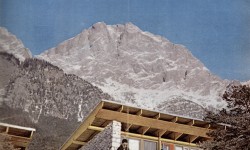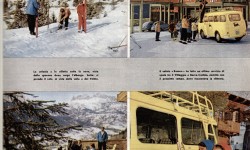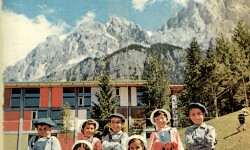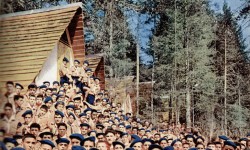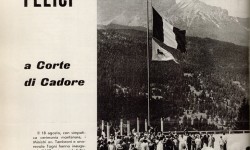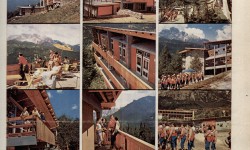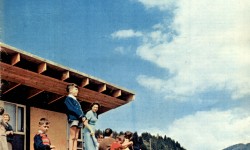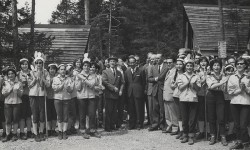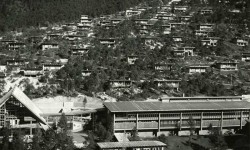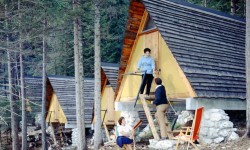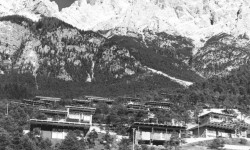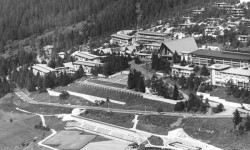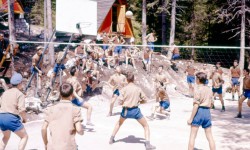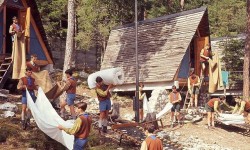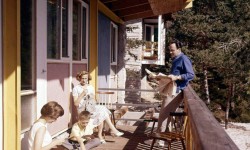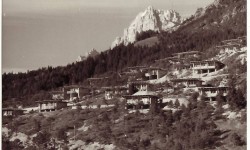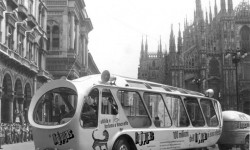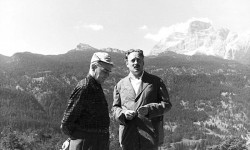In 1955 Enrico Mattei feels the need for a new communication device inside the company, and after discussing the matter with the head of Eni’s Press Relations office, Tito De Stefano, decides to trust the editing of a company periodical to the poet Attilio Bertolucci, a school friend of De Stefano’s.
“Il Gatto Selvatico” (Eng.: “The Wild Cat”), according to Enrico Mattei, should have been “a meeting point for all those that are part of the Eni Group’s great family”.
“Il Gatto Selvatico” was continuously published between 1955 and 1963.
The poet (Bertolucci) recalls the meeting with Mattei in via del Tritone, at the Agip headquarters, in which he brought a copy of an oil company magazine as an example of what not to imitate, because it was “a vert elegant magazine with merely three or four pieces talking about anything that isn’t oil, good for public relations, or to be brought to a parlor, intended for people outside the group”. Mattei wanted a “readable” magazine that everyone could enjoy, from the President Of the Italian Republic to the farthest of Eni’s punch card operators, thus a modern illustrated news magazine, not a slick-printed deal.When the title choice issue came to light, Bertoldi himself proposed the title as, in oil-producing slang, a “wildcat” is a person who seeks the petroleum “adventurous people, sometimes even adventurers”, said the poet, to which Mattei replied: “I wouldn’t mind being an adventurer, but for the State [...] Very well, then [...] A part of the magazine was dedicated to the activities of the company. The cover itself, in colour, had to always involve Eni in some way”. Bertolucci immediately got started on the task of setting up the magazine, with De Stefano’s collaboration: a part of it devoted to the activities of the corporation, both oil-related research and “the smallest company-related news”; a part devoted to cultural divulgation, crafted in a way that could make the magazine “seem both pleasant and instructive”; a part dedicated to “lifestyle”; several columns; Mino Maccari (author of the title’s font, as well)’s cartoon. The cover, with a picture related to Eni – in wasn’t going to be that way only a handful of times – and the last page, where Mattei told Bertolucci to do as he pleased; the poet chose to use it to explain in a “light” way the history of art. Contests were going to be launched, readers invited to send poetry, drawings, so that the company may establish a direct contact with its employees. The initial greeting was going to be the only one written by the president on the monthly publication, while the chief editor was going to make it, in time a magazine of some cultural importance, even if Bertolucci always urged the readers to consider the “Gatto” not like any magazine, “but like a family member”. Many known writers and poets would collaborate to the magazine, as well as many promising young people, who would be sent to the working locations, following the example of what happened in “Civiltà delle Macchine” (Eng.: Civilization of the Machines), which in those years was inaugurating the dialogue between humanistic and scientific culture. Bertolucci would manage the periodical until September 1963, when he would be replaced by Franco Briatico, but his pieces on art would still be published during the following two years, with the last column being dedicated to the “modern landscapes”. By this point, the magazine was heading towards its closing, which happened in the first months of 1965. After Mattei’s death the editor’s editorials became shorter and characterized by a softer tone. When “Il Gatto Selvatico” first was published, the staff was composed by chief editor Attilio Bertolucci, by Sergio Levi as assignment editor, “borrowed” from Eni’s publicity office, hired at half-service in both structures, by Paini with the function of “editor of the business section”, and by Gianni Baldi (who in 1962 will be made responsible of the illustrated news magazine of the “Il Giorno”, an Italian daily newspaper) as layout artist. The first issue of the “Il Gatto Selvatico” is published in July 1955, is twenty pages long, including the four used for the cover, which is printed in colour and large format (25x31cm), and with many pictures, in the wake of the weekly publications’ phenomenon, as were the “Domenica del Corriere”, “Oggi”, and “Epoca”, which from 1950 forward saw their sells skyrocket. After the first three twenty-page-long issues, their lenght is increased to twenty-four, which would remain the same in 1956, except for the double issues, the summer one (July and August) and the Christmas one (November and December), which would be 32 pages long. Ever since the first year, some inner pages would be printed in colour as well. 1957′s year’s issues, too, would be published with twenty-four pages, except for the issues of March and September, with 28, and December, with 36. From the editorials and the setting of the magazine it’s easy to understant that “Bertolucci’s cultural operation in the usage of artistic and literary materials moves from an educational goal: the reader, never jobbed, is, rather, guided, with discretion, but with audacity as well, towards an approach to literary experiences “valuable for everyone” “. Famous writers respond to this intention for collaboration, writers like Giorgio Caproni (whom, on the first number, signs the short story “La tromba del silenzio”, “the trumpet of silence”, in English), Alfonso Gatto, Filiberto Menna, Carlo Cassola, Carlo Emilio Gadda, Leonardo Sciascia, Raffaele La Capria, Enzo Siciliano and many others, asked to talk about themes of Italian and foreign literature, contemporary one as well.
Here a selection of vintage pictures, taken between the 50s and 70s, at the Eni Village of Borca di Cadore.

